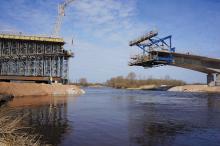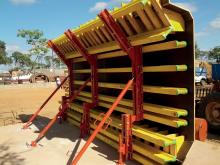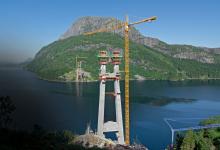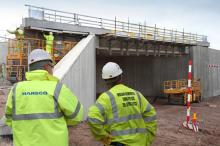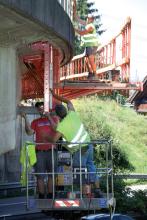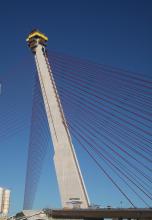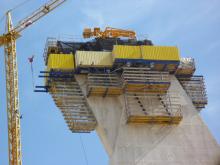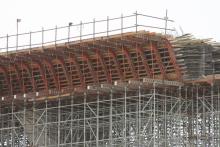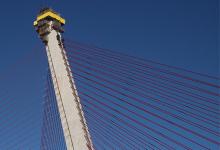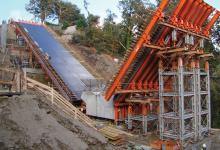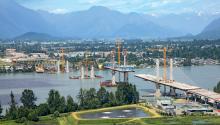An array of innovative formwork solutions have helped in the repair and construction of key bridge links - Mike Woof writes
Formwork producers are continually developing novel solutions for bridge maintenance and construction applications. Several key structures have benefited from the novel use of formwork systems, with suppliers such as Doka, PERI, Pilosio and RMD all working on important structures in recent times.
In Estonia, construction work is underway on the bypass around Tartu, the country’s
In Estonia a new bridge is being built with the help of Doka formwork and will carry the bypass around the city of Tartu and help cut congestion
An array of innovative formwork solutions have helped in the repair and construction of key bridge links - Mike Woof writes
Formwork producers are continually developing novel solutions for bridge maintenance and construction applications. Several key structures have benefited from the novel use of formwork systems, with suppliers such as203 Doka, 298 PERI, 7163 Pilosio and RMD all working on important structures in recent times.
In Estonia, construction work is underway on the bypass around Tartu, the country’s second largest city. This large-scale infrastructure project is using some novel formwork engineering techniques, as bridging the Emajõgi River is one of the major challenges.
The bypass is needed as traffic volumes are increasing in and around Tartu. However the bypass project has faced a number of topographical hurdles, with crossing the Emajõgi River providing the biggest test. To meet this challenge lead contractor K-MOST AS turned to Austrian formwork specialist Doka, a company it has cooperated with over many years.
The new-build Tartu Bridge will be 400m long overall and 15.5m wide when it is complete in late 2015. Most of the formworking can be done on compacted riverbank subsoil with the load-bearing towers Staxo 100. The river could not be dammed or even diverted however, so shoring over the full span was not an option. And so a high-performing Doka cantilever forming traveller has been employed to throw the 55m middle section of the bridge across the waters. The concreting sections are 5.1m long. Doka formwork instructors were in attendance to coordinate setup and familiarise the site crew with the procedures. A formwork instructor was also on site for the cantilever forming traveller's first advance. From the second concreting section onwards, the site crew was well able to take charge of the advancing procedure without further assistance. The cantilever forming traveller was on site for only a very short time, so the project owner has benefited from the Doka Group's rental model. Instead of being bought outright, the formwork system is simply hired for the duration. Usage of the formwork system is billed by the day and the equipment is returned as soon as the job is done.
Doka has a branch in Estonia, so formwork engineers being on call to answer queries and communications in the local language benefited the entire construction crew.
Meanwhile in Austria, formwork from PERI has been used to help rebuild an existing highway bridge, while allowing traffic to continue to use the structure. The work to the Inn Valley Bridge on the A12 highway was required as this structure, which was built in the 1970s, had to be maintained and also widened, involving a number of improvements to its structure. Specially modified equipment from PERI was used and this allowed traffic using the road to remain largely unaffected during the construction period.
While the need for the work was pressing to widen the bridge, it was also understood that the construction operation could not affect traffic flow. Austria’s A12 autobahn between Kufstein and Innsbruck forms part of a major European transport corridor, a link in the route between Munich in southern Germany and Bolzano in northern Italy and eventually connecting to Italy’s key A4 autostrada, which runs east-west from Venice to Turin. For the rehabilitation and widening of the 185m long Inn Valley Bridge close to Radfeld, both carriageways were to remain largely unaffected so as to minimise traffic disruption and reduce delays. As a result, contractor945 Strabag chose a solution from PERI formwork and scaffolding, which was based on two complementary modular systems: the VARIOKIT engineering construction kit and the UP scaffolding system. The ease of handling of the components and their ability to be used together helped ensure that the project was carried out within the required time schedule, while also helping minimise construction costs.
When renewing the outer parapets on the north side two VARIOKIT systems were used. These run on rollers attached to the underside of the cantilever and also eliminate any disturbance on the superstructure. The existing drainage system was dismantled in several passes and the team then removed the old parapet. Next, the new parapet was constructed and the new drainage pipes installed. In addition, the mobile platform also served to store and transport the resulting rubble.
To update the drainage around the internal cantilevers a mobile PERI UP suspended scaffold system was used. This was suspended between the two superstructures using DW 15 tie rods, suspended above and fixed securely to a trolley from VARIOKIT system parts.
Similarly, the Italian company Pilosio is working on an important contract in South Africa, supplying temporary structures to a construction site for a new motorway junction north of the city of Durban. The work is being handled by the South African branch of CMC of Ravenna. The project is complex and includes the construction of two of the longest viaducts in the country.
Pilosio’s sophisticated technical solution, including the substantial degree of customisation offered by its products, were decisive in the choice of this supplier for the project in South Africa. The Pilosio products have been used for temporary structures for the N2-M41 Mount Edgecombe Interchange in Durban.
Italian contractor CMC is employing Pilosio equipment to construct two large viaducts, using the casting system, which avoids any interference with the traffic below.
The viaducts measure 26m high by 947m long, and 18m high by 443m long. Once complete, the larger of the viaducts will be the longest in South Africa and CMC’s project is worth some €83 million.
Pilosio has supplied 200m2 of P300 formwork for foundations and trusses, 500m2 of special steel formwork divided into five sets for the construction of the viaduct pile shafts. There was also an additional 350m2 of special steel formwork made up of three sets for the construction of the pier caps, two sets of Maximix model formwork and custom-made products for a total of 940m2. In addition the order included the Omnimode shoring system with customised solutions to set up the suspended work platforms for the installation phase of the roadway structure. The motorway interchange to be constructed by CMC will also include junction work such as slip roads and underpasses, which are also largely being constructed using Pilosio equipment.
The technical solution offered by Pilosio was a key factor in winning the order, with around 70% of the equipment being customised for the project. These special systems are being used for the construction of the piles, the pier caps and the base of the roadway. Pilosio’s technical office provided a quick and detailed solution for the critical areas of the construction site. This emphasised rapid supply times, coordination with the various organisations involved in the project and the requirement to design a formwork system for the piles that could be adapted to two different sizes and for the roadways of the viaducts (optimised for buttress installations).
Lastly, specialist formwork and shoring solutions from319 RMD Kwikform are being used by contractor Dragages - China Harbour - VSL Joint Venture to build a key section of the $10.3 billion Hong Kong – Zhuhai – Macao Bridge (HKZMB). This megastructure will connect Hong Kong to China across the Pearl River and presents many technical challenges, due to its sheer scale as well as the climate and geographic conditions.
Commissioned by the Chinese Government, the HKZMB is the largest infrastructure project ever built in Hong Kong. Once complete it will establish a new transport link between Hong Kong, Macao and Zhuhai, towards the Western Pearl River Delta, and will be one of the world’s longest bridges.
In order to connect the main bridge with the Boundary Crossing Facility, DCV JV is constructing part of the 12.9km, dual three lane Hong Kong Link Road section, with a contract value of $3.2 billion.
Constructed as a design and build project, the RMD Kwikform team in Hong Kong was given the task of supporting the site team on a number of levels. The first was to provide an engineering solution for the construction of numerous land piers and portal beams, whilst also providing specialist pier forms for the marine sections.
With a large amount of bespoke elements required for the project, once designed, RMD Kwikform engaged local suppliers to fast-track the fabrication of the key components needed to support each section. This allowed the DCV JV team to go from design signoff to site erection in just 12 weeks. To further assist the team, RMD Kwikform provided dedicated customer service technicians to support the safe erection of equipment and the phasing of the design and build elements.
Noel Kennedy, country director for the firm said, “The scale of this project required a great deal of organisation, design and logistics in order to meet the tight timescales. For DCV JV timing was critical, as the design and build nature of the project meant that any delays would have had a major impact on its delivery.
“By working closely with the engineering team, we were able to provide timely formwork designs for the Land Viaduct piers and portals, plus the Marine Viaduct piers, each varying slightly in design requirements. This allowed the project to stay on time and programme.”
To support the construction of the Land Viaduct piers, RMD Kwikform engineers designed specially fabricated formwork with integrated working platforms, allowing safe and economical access/egress, which also helped to increase productivity.
Above the piers, portal beams up to 38m in length and 5m in depth had to be constructed utilising various RMD Kwikform solutions. Fixed to either side of the main columns, eight pre-fabricated brackets were designed to hold the weight of the beams for the majority of the portal construction, however, due to certain site constraints, this needed to be adopted to suit each pier.
For the larger beams the prefabricated bracket arrangement was further supported by Megashor tower and Rapidshor birdcage shoring arrangements, which were erected from the ground. This was further supplemented with designs of plate girders spanning large “live traffic” road openings, supported by Megashor towers. Rapidshor shoring was then placed adjacent to and above these plate girders to form the soffit of the portal beams.
As part of the overall pier formwork solution, RMD Kwikform engineers designed integrated access platforms to support the erection teams whilst they were working on the complex linkage sections of the formwork. These included void spaces and protruding sections, each created at different angles to allow for the precast bridge segments to be mounted to the piers. With the void spaces housing the tension cables, each pier had to support two precast sections, which were then joined together with other sections using a launcher to form the bridge deck.
Commenting on the project PS Choi, senior construction manager said, “Because every span is slightly different, due to the shape and direction of the bridge design, we needed a supplier that could support us technically, whilst being very flexible to our needs. When you are constructing such a large project in a design and build format, it is also important to make the right commercial, as well as design, decisions.”
With five sets of brackets and multiple sets of plate girders supplied for use on the project the site team was able to work simultaneously on a number of work fronts. In order to achieve this cycle time, RMD Kwikform engineers had to provide timely drawings and designs for each location. It was then the role of the on-site customer service personnel to support the site team with training and safety checks to ensure each pier and portal installation was executed effectively.
When it came to the construction of the Marine Piers, RMD Kwikform designed a special steel column form, fabricating a number of units to support the project, each of which weighed approximately 7tonnes. In order to speed up the project cycle times, whole units were erected on land and mounted onto large crane carrying barges. The barges then transported the column forms to the cast in-situ concrete foundations, where they were lifted and secured into place. For added support, steel Superslim soldier bracing members were anchored to the foundations and connected to fixing points on the column form.
The concrete was then poured, with each column struck by relaxing the Superslim bracing and using the in-built turnbuckles to push the four corners of the column forms open. This allowed the site team to keep the structure of the column forms together, so they could be lifted away as a whole unit, back onto the barge and moved to the next column pour.
Commenting on the mobilisation for the project Kennedy said, “From design to site erection we had just three months to deliver the special items for this project. In order to achieve this we worked with three separate steel fabricators. We also had a yard nearby with all of our standard equipment needed to support the project.”
The Hong Kong – Zhuhai – Macao Bridge (HKZMB) is a massive project, first suggested in 1983, with construction beginning in 2009 and due for completion in 2016. The bridge will span 29km, making it one of the world’s longest bridges.
Formwork producers are continually developing novel solutions for bridge maintenance and construction applications. Several key structures have benefited from the novel use of formwork systems, with suppliers such as
In Estonia, construction work is underway on the bypass around Tartu, the country’s second largest city. This large-scale infrastructure project is using some novel formwork engineering techniques, as bridging the Emajõgi River is one of the major challenges.
The bypass is needed as traffic volumes are increasing in and around Tartu. However the bypass project has faced a number of topographical hurdles, with crossing the Emajõgi River providing the biggest test. To meet this challenge lead contractor K-MOST AS turned to Austrian formwork specialist Doka, a company it has cooperated with over many years.
The new-build Tartu Bridge will be 400m long overall and 15.5m wide when it is complete in late 2015. Most of the formworking can be done on compacted riverbank subsoil with the load-bearing towers Staxo 100. The river could not be dammed or even diverted however, so shoring over the full span was not an option. And so a high-performing Doka cantilever forming traveller has been employed to throw the 55m middle section of the bridge across the waters. The concreting sections are 5.1m long. Doka formwork instructors were in attendance to coordinate setup and familiarise the site crew with the procedures. A formwork instructor was also on site for the cantilever forming traveller's first advance. From the second concreting section onwards, the site crew was well able to take charge of the advancing procedure without further assistance. The cantilever forming traveller was on site for only a very short time, so the project owner has benefited from the Doka Group's rental model. Instead of being bought outright, the formwork system is simply hired for the duration. Usage of the formwork system is billed by the day and the equipment is returned as soon as the job is done.
Doka has a branch in Estonia, so formwork engineers being on call to answer queries and communications in the local language benefited the entire construction crew.
Meanwhile in Austria, formwork from PERI has been used to help rebuild an existing highway bridge, while allowing traffic to continue to use the structure. The work to the Inn Valley Bridge on the A12 highway was required as this structure, which was built in the 1970s, had to be maintained and also widened, involving a number of improvements to its structure. Specially modified equipment from PERI was used and this allowed traffic using the road to remain largely unaffected during the construction period.
While the need for the work was pressing to widen the bridge, it was also understood that the construction operation could not affect traffic flow. Austria’s A12 autobahn between Kufstein and Innsbruck forms part of a major European transport corridor, a link in the route between Munich in southern Germany and Bolzano in northern Italy and eventually connecting to Italy’s key A4 autostrada, which runs east-west from Venice to Turin. For the rehabilitation and widening of the 185m long Inn Valley Bridge close to Radfeld, both carriageways were to remain largely unaffected so as to minimise traffic disruption and reduce delays. As a result, contractor
When renewing the outer parapets on the north side two VARIOKIT systems were used. These run on rollers attached to the underside of the cantilever and also eliminate any disturbance on the superstructure. The existing drainage system was dismantled in several passes and the team then removed the old parapet. Next, the new parapet was constructed and the new drainage pipes installed. In addition, the mobile platform also served to store and transport the resulting rubble.
To update the drainage around the internal cantilevers a mobile PERI UP suspended scaffold system was used. This was suspended between the two superstructures using DW 15 tie rods, suspended above and fixed securely to a trolley from VARIOKIT system parts.
Similarly, the Italian company Pilosio is working on an important contract in South Africa, supplying temporary structures to a construction site for a new motorway junction north of the city of Durban. The work is being handled by the South African branch of CMC of Ravenna. The project is complex and includes the construction of two of the longest viaducts in the country.
Pilosio’s sophisticated technical solution, including the substantial degree of customisation offered by its products, were decisive in the choice of this supplier for the project in South Africa. The Pilosio products have been used for temporary structures for the N2-M41 Mount Edgecombe Interchange in Durban.
Italian contractor CMC is employing Pilosio equipment to construct two large viaducts, using the casting system, which avoids any interference with the traffic below.
The viaducts measure 26m high by 947m long, and 18m high by 443m long. Once complete, the larger of the viaducts will be the longest in South Africa and CMC’s project is worth some €83 million.
Pilosio has supplied 200m2 of P300 formwork for foundations and trusses, 500m2 of special steel formwork divided into five sets for the construction of the viaduct pile shafts. There was also an additional 350m2 of special steel formwork made up of three sets for the construction of the pier caps, two sets of Maximix model formwork and custom-made products for a total of 940m2. In addition the order included the Omnimode shoring system with customised solutions to set up the suspended work platforms for the installation phase of the roadway structure. The motorway interchange to be constructed by CMC will also include junction work such as slip roads and underpasses, which are also largely being constructed using Pilosio equipment.
The technical solution offered by Pilosio was a key factor in winning the order, with around 70% of the equipment being customised for the project. These special systems are being used for the construction of the piles, the pier caps and the base of the roadway. Pilosio’s technical office provided a quick and detailed solution for the critical areas of the construction site. This emphasised rapid supply times, coordination with the various organisations involved in the project and the requirement to design a formwork system for the piles that could be adapted to two different sizes and for the roadways of the viaducts (optimised for buttress installations).
Lastly, specialist formwork and shoring solutions from
Commissioned by the Chinese Government, the HKZMB is the largest infrastructure project ever built in Hong Kong. Once complete it will establish a new transport link between Hong Kong, Macao and Zhuhai, towards the Western Pearl River Delta, and will be one of the world’s longest bridges.
In order to connect the main bridge with the Boundary Crossing Facility, DCV JV is constructing part of the 12.9km, dual three lane Hong Kong Link Road section, with a contract value of $3.2 billion.
Constructed as a design and build project, the RMD Kwikform team in Hong Kong was given the task of supporting the site team on a number of levels. The first was to provide an engineering solution for the construction of numerous land piers and portal beams, whilst also providing specialist pier forms for the marine sections.
With a large amount of bespoke elements required for the project, once designed, RMD Kwikform engaged local suppliers to fast-track the fabrication of the key components needed to support each section. This allowed the DCV JV team to go from design signoff to site erection in just 12 weeks. To further assist the team, RMD Kwikform provided dedicated customer service technicians to support the safe erection of equipment and the phasing of the design and build elements.
Noel Kennedy, country director for the firm said, “The scale of this project required a great deal of organisation, design and logistics in order to meet the tight timescales. For DCV JV timing was critical, as the design and build nature of the project meant that any delays would have had a major impact on its delivery.
“By working closely with the engineering team, we were able to provide timely formwork designs for the Land Viaduct piers and portals, plus the Marine Viaduct piers, each varying slightly in design requirements. This allowed the project to stay on time and programme.”
To support the construction of the Land Viaduct piers, RMD Kwikform engineers designed specially fabricated formwork with integrated working platforms, allowing safe and economical access/egress, which also helped to increase productivity.
Above the piers, portal beams up to 38m in length and 5m in depth had to be constructed utilising various RMD Kwikform solutions. Fixed to either side of the main columns, eight pre-fabricated brackets were designed to hold the weight of the beams for the majority of the portal construction, however, due to certain site constraints, this needed to be adopted to suit each pier.
For the larger beams the prefabricated bracket arrangement was further supported by Megashor tower and Rapidshor birdcage shoring arrangements, which were erected from the ground. This was further supplemented with designs of plate girders spanning large “live traffic” road openings, supported by Megashor towers. Rapidshor shoring was then placed adjacent to and above these plate girders to form the soffit of the portal beams.
As part of the overall pier formwork solution, RMD Kwikform engineers designed integrated access platforms to support the erection teams whilst they were working on the complex linkage sections of the formwork. These included void spaces and protruding sections, each created at different angles to allow for the precast bridge segments to be mounted to the piers. With the void spaces housing the tension cables, each pier had to support two precast sections, which were then joined together with other sections using a launcher to form the bridge deck.
Commenting on the project PS Choi, senior construction manager said, “Because every span is slightly different, due to the shape and direction of the bridge design, we needed a supplier that could support us technically, whilst being very flexible to our needs. When you are constructing such a large project in a design and build format, it is also important to make the right commercial, as well as design, decisions.”
With five sets of brackets and multiple sets of plate girders supplied for use on the project the site team was able to work simultaneously on a number of work fronts. In order to achieve this cycle time, RMD Kwikform engineers had to provide timely drawings and designs for each location. It was then the role of the on-site customer service personnel to support the site team with training and safety checks to ensure each pier and portal installation was executed effectively.
When it came to the construction of the Marine Piers, RMD Kwikform designed a special steel column form, fabricating a number of units to support the project, each of which weighed approximately 7tonnes. In order to speed up the project cycle times, whole units were erected on land and mounted onto large crane carrying barges. The barges then transported the column forms to the cast in-situ concrete foundations, where they were lifted and secured into place. For added support, steel Superslim soldier bracing members were anchored to the foundations and connected to fixing points on the column form.
The concrete was then poured, with each column struck by relaxing the Superslim bracing and using the in-built turnbuckles to push the four corners of the column forms open. This allowed the site team to keep the structure of the column forms together, so they could be lifted away as a whole unit, back onto the barge and moved to the next column pour.
Commenting on the mobilisation for the project Kennedy said, “From design to site erection we had just three months to deliver the special items for this project. In order to achieve this we worked with three separate steel fabricators. We also had a yard nearby with all of our standard equipment needed to support the project.”
The Hong Kong – Zhuhai – Macao Bridge (HKZMB) is a massive project, first suggested in 1983, with construction beginning in 2009 and due for completion in 2016. The bridge will span 29km, making it one of the world’s longest bridges.

